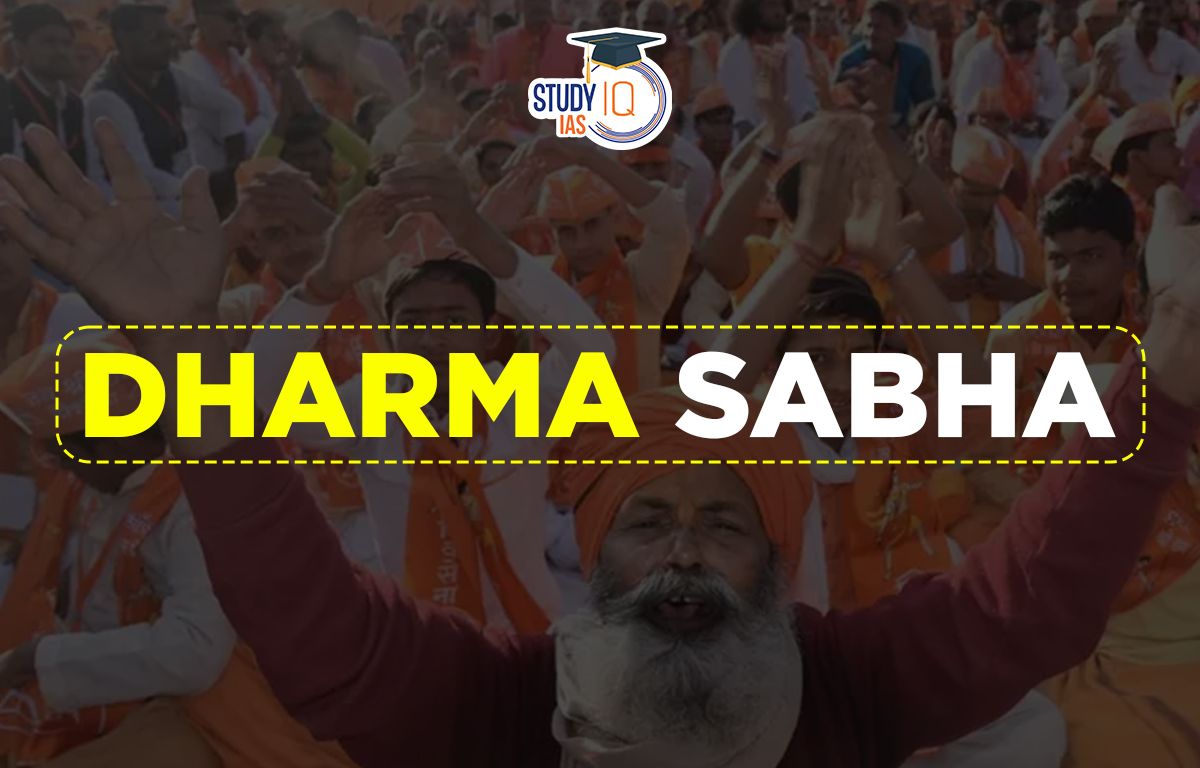Table of Contents
Dharma Sabha
Dharma Sabha was founded by Radhakanta Deb. It was a traditional community that supported preserving the status quo in socioreligious matters and opposed the abolition of sati. However, it did assist in the advancement of Western education, particularly that for girls. Read all about Dharma Sabha in this article, UPSC aspirants can find all the information related to Dharma Sabha for their preparations.
Read More: Ramakrishna Mission
Dharma Sabha History
India’s social consciousness underwent ongoing change as a result of the consolidation of colonial rule and the introduction of Western education. The fact that Western education was assisting Indians in challenging dogma and orthodoxy was cause for excitement for many. But many saw it as a danger to Indian spirituality and cultural values. Different socioreligious movements were forming against these backdrops in colonial 19th-century India.
In this context, it is possible to talk about socioreligious movements like Dharma Sabha and Manav Dharma Sabha. In reaction to Brahmo Samaj and other reformist groups with a Western focus, Dharma Sabha was created. A fresh campaign to restore the lost splendours of Indian history was organised by conservative Hindu groups because they believed it was important. Raja Radhakant Deb started the Dharma Sabha in Calcutta in 1830.
Read More: Young Bengal Movement
Dharma Sabha Objective
Dharma Sabha’s main objective was to combat Brahmo Samaj’s propaganda that supported Western values. Dharma Sabha’s main priority in 1829 was to resist Lord William Bentinck’s legislation that would have outlawed Sati. Dharma Sabha had a traditionalist bent. It supported keeping Hindu Socio-Religious practises and beliefs as-is. Dharma Sabha had a political bent as well because it opposed the invasion of colonial values. Dharma Sabha celebrated Indian culture’s importance and pride.
They rejected Western ideals as an alien and colonial intrusion that would damage Indians’ sociocultural diversity. Dharma Sabha’s theory of cultural critique served as the cornerstone for Hindu nationalism in India. The primary goal of Dharma Sabha was to thwart the influence of Western culture. It had some appreciation for Western education and saw the increased emphasis on girls’ education as a necessary and constructive development.
To ensure social reform, the Dharma Sabha lacked a clear agenda. They did not support a reformer hero who questioned Hindu social and religious customs like Raja Ram Mohan Roy. When Sabha opposed the British legislation that outlawed the Sati system, its status quo goal became evident. They perceived the prohibition of Sati pratha as an unwelcome intrusion by foreigners into Indian culture and religious concerns. Dharma Sabha therefore urged that the British law be abolished.
Read More: Arya Samaj
Dharma Sabha Feature
In the issue of widow remarriage, Dharma Sabha’s fixation on traditional Hindu traditions was even more obvious. The Hindu Widow Remarriage Act of 1856 was once more criticised by the Sabha. It collected signatures from the Hindu populace as part of its campaign to oppose the law that permits Hindu widow remarriage. Compared to the effort started by Iswarchandra Vidyasagar, the campaign was successful in collecting more signatures. Lord Dalhousie supported the passage of a statute permitting Hindu widow remarriage once more.
On Lord Canning’s insistence, the Hindu Widow Remarriage Act of 1856 was later enacted. Dharma Sabha’s principal goal was to uphold Hindu culture and way of life. It offered a foundation for the Hindu understanding of Indian national consciousness. Dharma Sabha, which was inspired by Hindu cultural values, did not view it as essential to fight against the caste system, child marriage, widow remarriage, or the Western educational system.
Read More: Reformist Movements & Revivalist Movements
Dharma Sabha Significance
Dharma Sabha’s founding inspired the creation of a number of additional hardline Hindu organisations. Sanatana Dharma Sabha (1895), Dharma Maha Parishad, and Dharma Mahamandali were a few of the conservative platforms. In especially in South and East India, the conservative movements developed widely. Hindu conservative cultural and religious movements become more popular at the turn of the 20th century.
In 1902, the majority of the fundamentalist Hindu factions united to create the Bharat Dharma Mahamandala, which had Varanasi as its capital. The culmination’s major goal was to support Hindu religious institutions, especially in the area of traditional education. In order to strengthen the Hindu right-wing movement, Pandit Madam Mohan Malviya played a crucial role.
Dharma Sabha UPSC
Founded in Calcutta in January 1830, the Dharma Sabha was a group of orthodox Hindus who opposed the government’s decision to outlaw the long-standing Hindu custom of sati. Many orthodox Hindus considered the requirement that Hindu widows burn themselves alive on the funeral pyre of their deceased husbands to be an act of piety. The information regarding Dharma Sabha for UPSC Exams is provided in this article.


 Important Lakes of India, State wise and...
Important Lakes of India, State wise and...
 Buddhism History, Origin, Sect, Councils...
Buddhism History, Origin, Sect, Councils...
 Andaman and Nicobar Islands, History, Cl...
Andaman and Nicobar Islands, History, Cl...





















